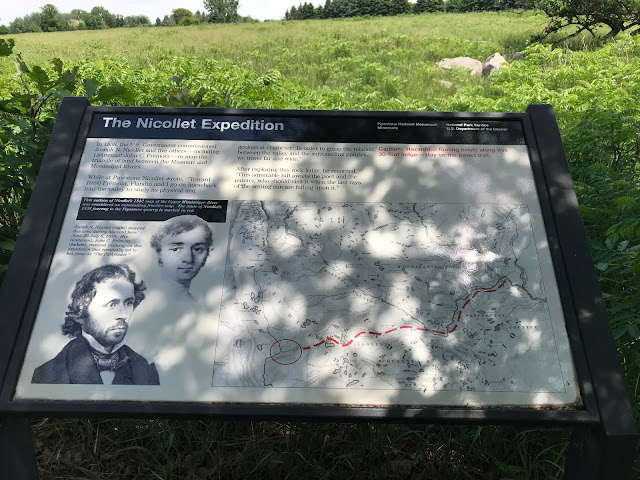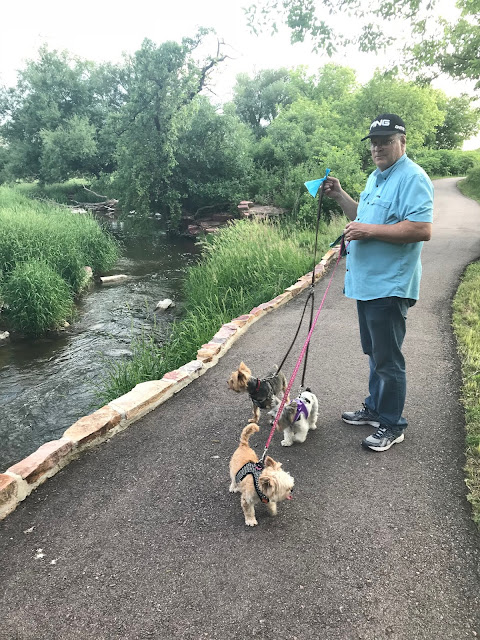Photos from the Interpretive Center
Per the National Park Service, the Iowa and Oto are believed to be the first tribal groups to quarry the Pipestone. Sioux, Mandan, Ponca and Sauk & Fox people as being some of the earliest tribes to quarry the stone. By the 1700s, the Yankton Sioux had laid claim to the quarries, but the Sisseton-Wahpeton, Santee and Flandreau also utilized the quarries. Pipestone was traded extensively throughout most of North America. Eastern Dakota tribes traded pipes with western tribes such as the Tetons at the James River Rendezvous which occurred every ear until white intrusion into the area because too powerful. By the late 1800s, groups of Sioux still came to quarry on a yearly basis. Joe Taylor, a Mdewakanton Sioux was probably the most active quarrier in the area until about 1939. Taylor, as well as others who would follow him, quarried in small family groups. James Balmer, the superintendent of the nearby Indian school, administered the quarrying operation until 1937 when the National Park Service took over. Interest in quarrying remained at a low level into the early 1950s with no more than four permits issued for any given year. Three local Chippewa and Sioux families - the Bryans, Derbys, and Taylors - kept the craft of pipe-making alive during the 1950s. For the most part, these crafters learned to carve from their ancestors as the skill was passed from generation to generation. Up until the 1960s, the Pipestone quarries were worked by a small group of men who used the same quarry pits each year. Between 1966-1973, quarries jumped from 10 to 23. Today, the number of quarry permits issued by the park has reach 56. Most of today's quarriers are from the Dakotas, Minnesota, Wisconsin, Nebraska, and other parts of the US. To read more, click here. There's quite a history to this monument!
Also at Pipestone National Monument is a bookstore and gift shop. Even Pipestone dust is sold there. Nothing of the stone is thrown away. If pieces are small, they carve those into earrings, necklaces, etc.
Today, I met Coty Tellinghuisen and his mother, Pam today. Coty is a 33 year old quarrier, who with his family, have been quarrying the stone for three generations. I watched him carve today and he showed me how he does it with hacksaw and varying degrees of files to achieve the look he is achieving. I learned that the light weight pipe comes from the top layer of Pipestone that is fragile. The heavier the weight of the Pipestone, the stronger the stone. He uses tools all by hand and feels it's more like the traditional way.
Coty is a 5th generation artist and has been carving Pipestone for over five years. He learned his art from his mom and his grandmother, Betty Derby-Tellinghuisen. He and Pam are members of the Pipestone Indian Shrine Association. Coty and Pam are descendants of Moses Crow and Estelle Crow-Wilson who settled in Pipestone around 1927 to work the Pipestone quarries and carve the Pipestone rock. They are lineal descendants of the Sisseton-Wahpeton Dakota Nation.
 |
| Coty Tellinghuisen, Pipestone Pipe Maker |
 |
| Coty's Pipe...that I bought! |
There is a 3/4 mile walking trail located behind the Visitor Center where you will see some lovely sites. Dogs can walk the paths but must be leashed. Here are some on the sites you see on the Circle Trail:
The Oracle - a natural statue of Quartzite that Native Americans consider the guardian of the quarries. It is believed that the Oracle will impart wisdom to quarriers who show their respect by leaving offerings and prayers.
Winnewissa Falls - According to one American Indian story: "The Great Spirit called the warring nations together in the valley of Pipestone. There he pulled a piece of Pipestone from the earth, formed a pipe and told them that it was the flesh and blood of their ancestors. He smoked the pipe over them and admonished them to lay down their arms. Here is a place where different tribes can quarry side by side together in harmony. While he was speaking, a water fall poured from the rock nearby".
Leaping Rock - Explorers had their curiosity aroused when they saw arrows stuck in the crack atop Leaping Rock. They learned from the Indians that traditionally a young warrior, to prove his valor, leaped this chasm and placed an arrow in the crack. It was also related that on occasion a virtuous woman might refuse to accept the attentions of young warrior until he had shown bravery by jumping onto Leaping Rock.
Nicollet Marker - Initials in this rock by Joseph Nicollett and his expedition in July 1838. Nicollet headed the first US Govt sponsored expedition to the quarries and John Fremont jumped onto Leaping Rock placing a US flag there signifying the presence of the United States.
Smooth Sumac - These shrubs were smoked in their pipes when the bright red leaves were gathered in the fall and dried for smoking.
Lake Hiawatha - The small lake is named for Longfellow's mythical American Indian character, Hiawatha. This pond used to be a low lying swampy area, but a dam was constructed in the 1930's to enlarge and deepen the pond, creating a natural swimming pool for American Indian children housed at the nearby Pipestone Indian Boarding School. This small oasis, teeming with life, supports many plants, animals and tree species.
There are also trails to see a few of the 56 quarried sites - all by separate Native American tribes and bands who are constantly quarrying their stone.
Another interesting thing about Pipestone is the flora and native grasses and other plants. There are in abundance and I saw at least one rabbit, 8 deer, lizards, and some strange animal that look half lizard half squirrel. I want to find out what it was! Also, you'll see prayer strips on trees and shrubs.
Also, near the entrance to Pipestone is The Three Maidens. They are six huge boulders. They are not Quartzite nor Pipestone but Granite! There are NO other granite rocks anywhere else around! They say they were carried here from the north by a glacier and left behind when the ice melted. Rocks like these are called erratics. Tiny erratics of granite are found in the soil all over the monument. The legend of the Three Maidens states that "when the moon was young, three daughters of a chief wanted to stay near the quarries while their tribe moved to different grounds. They spoke with the Great Spirit who said they could stay, that they would become part of the landscape (the rocks) and caretakers of the quarries." Others say that the three maidens (large boulders) shelter the spirits of maidens (smaller boulders) who require offerings from visiting Indians before permitting them to quarry Pipestone. Today, The Three Maidens are held sacred by Native American and pray here before digging their stone. Prayer offerings are common here.
Tonight, I walked the trail again with Scott and the dogs. I loved the hike so much I wanted Scott to experience it when we was off work. It was another glorious walk and we only saw one other couple on the trail with one of their dogs, Kyah.
Visitor Center Hours are from 8:30 a.m. to 5:00 p.m. daily except for Thanksgiving, Christmas and New Years Day. There is parking for cars, buses and RVs. Plan on this visit. It's well worth the time. OH! And, there's a junior ranger program, too! While it only looks like a building from the outside, the wealth of information you get is a treasure!






























































Thanks for the pictures!
ReplyDeleteYou are so welcome...stay tuned. We're at Uncle Mark's house...
Delete